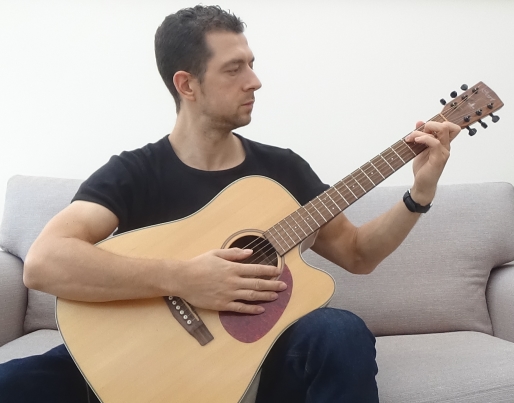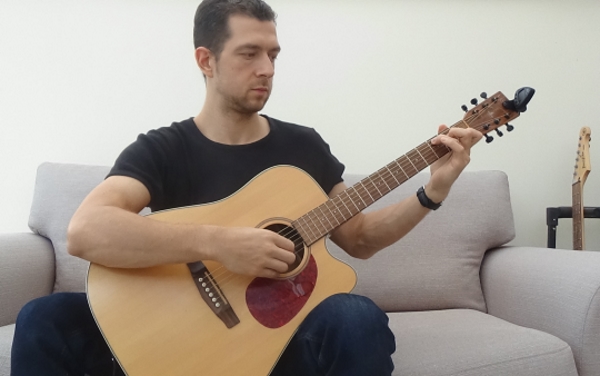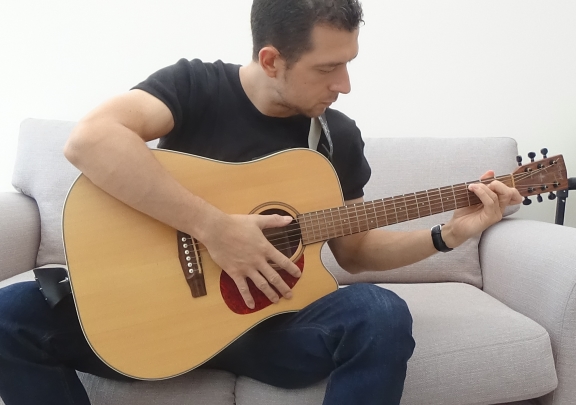Many people have no idea how to actually sit with their guitar for the most optimal playing comfort, efficiency and technique. Some sit in a downright terrible way. This places a huge strain on their wrists, leads to their backs being hunched over and their guitar being placed at a weird angle.
In this two-part post, I’ll explain why it is essential that you start sitting in the proper manner, why most teachers get it wrong, and what you can learn from the sport of golf. Most importantly I’ll show you what I have found to be by far the most optimal playing position for guitarists.
Not only do some guitarists sit with the guitar in a totally wrong position a lot of the time, they also constantly change how they sit with the guitar, often without realising it.
This means there is no consistency to their playing. One day they will be sitting in a certain way and the next in a different position.
Some days they will sit upright in a good position and others they will slouch back in an armchair in a totally different posture.
If you wonder why some days you can play better than others, this could be the reason.
For example:
- One day they might be in a good playing position which allows their fretting hand to be in the ideal (or close to it) place just like in the image below…
- The next day they might sit in a slightly (or very) different position, putting their fretting hand half an inch somewhere else from where it was the previous day as seen in the image below….
Many guitarists, even experienced players, often don’t pay any attention to this but then get frustrated when some days things which should be simple, such as getting clear chords, are easy and other days there is the sound of the oh-so-annoying ‘muted strings’.
The D Major chord is a great test for your playing position
The test I use to identify a bad playing position is the D Major chord. If you get it right some days and other days your playing makes you want to jab things into your eyes out of frustration, or give up the guitar to live like a flute playing hermit, you may have bad or changing playing positions.
Everyone has had issues with this chord at some point, specifically with the high E string being muted by the back of the ring finger which is placed on the 3rd fret of the B string.
If you have never had this issue, I don’t believe you even play guitar!
There are lots more examples of how just changing your position and posture slightly can cause issues with not just the chords but everything else. It can make all the following awkward:
- Chords
- Scales
- Chord changes
- Strumming
- Riffs
- Fingerpicking
- Barre Chords
- ….and pretty much everything.
Chord changes might be slower as the awkward position causes too much tension in your body, meaning you would be fretting the notes with far too much pressure.
Playing with too much pressure is an important point to remember that relates closely to bad playing position, one I cover in my course Ninja Chord Changes.
Scales, riffs and melodies may be played with errors as you might be holding up the weight of the guitar with the fretting hand or your thumb might be sticking too far over the top of the neck.
Either of these can cause a misalignment of the fretting hand fingers in relation to the fretboard. This can easily cause you to place your fingers down not quite on the string but slightly off it, causing the dreaded sound of a ‘buzzing note’. This is most common with beginners.
Even the picking hand might be affected.
Fingerpicking and strumming tone would be weaker as when the guitar is not at the right angle your fingers – or pick – can easily pick down the string, causing a scratchy and unpleasant tone.
Barre chords too could be affected as they require great technique and some strength (not a lot, just enough) to be able to play cleanly. Also, with barre chords, it is important to be able to change to them quickly which many people forget to mention.
Poor playing position can cause a ‘crooked wrist’, which means you can’t inject much strength, and the strength you can apply will put more strain on your wrist which is not good for your long-term playing or health.
If you find there is no consistency to your playing, or your technique frustrates you, then you absolutely must take a close look at how you sit with the guitar.
Imagine a golfer doing this!
I often use this analogy. Imagine a golfer. If he were to wear his normal golfing shoes while playing, he would be okay when smashing the ball with his driver.
What would happen if one day he forgot his shoes and had to play barefoot?
He would be an inch closer to the ground and his whole posture would be ever so slightly out. This might cause him to hit the ball 2, 3, or 4 mm lower (or maybe higher) than usual and the contact just wouldn’t be the same. The ball could go anywhere.
Imagine one day he instead rocked up in 6-inch high heels (now a golfer in 6-inch heels is an interesting thought!) The ball could go literally anywhere!
That is what is happening when you are constantly changing your playing position
You are misaligning parts of your body, sometimes only a little and other times a lot. You then have to work really hard to overcome these issues, whether you realise it or not, and this gets in the way of your playing.
Take some time over the next week to think about and see how you actually sit with your guitar. There are no actual rules on how to sit – or even stand – with it, but there are guidelines.
I will go through them in the next part of this post, exactly what you should and shouldn’t do, but first become aware of what you are doing.
Ask yourself these questions and watch out for these things each time you play.
Are you sitting:
- on different chairs each time you play?
- in different parts of the chair?
- with the guitar placed on a different part of your body?
- with the guitar neck at a different angle?
- so that the headstock is located in a different position relative to your shoulder each day?
In the next part of this post, I’ll go over what I believe is the perfect playing position for maximal efficiency, enjoyment and technique.
This position can make a huge positive difference to the playing of a struggling beginner as well as being useful to more advanced players.
Spend the next week being more aware of your playing position by watching yourself in the mirror, filming yourself playing, and being more aware of where the guitar is located in regards to your body as well as your body’s location in relation to the chair.
Being aware of this will make a positive difference.
Leave a comment below and let me know what your thoughts are on your playing position;
- Are you consistent?
- Does it hurt to play?
- Are you uncomfortable when you play?
To make it more fun, the writer of the best comment will get a free copy of my eBook on fingerpicking technique, Fearless Fingerstyle.







Position is one of those things you never consider until it’s too late, that is, your neck starts to get sore, your back starts hurting, or you just get tired quickly.
And let’s not get started with how to play while standing up…
Hey, Max, too true.
I used to have awful left-hand wrist problems until I adjusted my posture – I just thought it came with the territory. To make it worse, I pressed far too hard so was causing extra stress on my wrist.
It can be rectified but the earlier a guitarist sorts it, the better for sure!
Thanks for getting in touch!
Dan
Nice post and thanks. My technique was all over the place for years. Sitting in the classical position has helped although I have found myself slipping into bad habits of sitting leaning forward and sitting awkwardly. It is something for me to keep on top of!
This is all too familiar, James. Keep reminding yourself.
I put a little sticky `post-it note` on a student`s guitar once, saying the words `CLASSICAL POSITION` in big letters, told him to leave it on the guitar all week.
Every time he slipped back into old habits the little note would remind him.
Give that a try and thanks for getting in touch.
Dan
Just to let you know, James, you win the book for best comment. Will email it over now.
Posture is one of the things I’ve never really noticed, but now that I’ve began doing so I’m realising I really don’t sit properly and this has been messing my playing. This makes so much sense, thanks Dan!
It really is a huge deal and I reckon unless taught it, about 90% of beginner guitarists get it wrong which makes a massive negative difference to their technique, comfort and enjoyment. Glad to have helped.
Hopefully, more guitarists will now realise like you and start to fix this in their playing.
Keep up the good work!
Keep up the good work, I’ve been learning so much these posts. Really appreciate it.
Thanks for all the tips, great help. Please don’t say (in bold) “most optimal” 🙂
No problem! Thanks, you are right about that too! ? Glad to have helped you though
[…] The problem, however, occurs when you try and rest your back on the backrest. In fact, the quality of the backrest is great but the design is not. Apparently, it does not really support you when you are sitting straight. You have to lean more backward in order to get its support and that is totally not an ideal guitar playing position. […]
[…] Part one of this series on how to sit with a guitar properly, I explained why good, solid and consistent […]
[…] the best of the classical world – Consider sitting with your guitar in the classical position (it can really help), practise with absolute focus, use pristine technique, and study classical […]